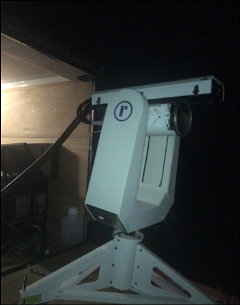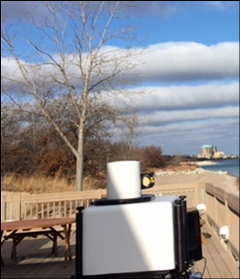LIDAR Observations of Complex Winds
David Kristovich, Junming Wang, Sudheer Bhimireddy, Sophia Sagrestano
Researchers at the Illinois State Water Survey use two state-of-the art light detection and ranging (LIDAR) systems to measure highly-complex wind systems and dispersion of atmospheric particles. This capability has allowed for unique observations of nighttime drainage flows in the U.S. Midwest, thunderstorm winds, lake-/sea-breezes, turbulence generated by buildings and wind turbines, and the daytime intensification of vertical (upward, downward) air motions, ultimately resulting in strong convective storms.


Recent Projects
Stable Atmospheric Variability and Transport (SAVANT)
LIDARs Objectives
- Observations of Nocturnal Stable Layer Drainage Flow in Shallow Topography
- Agricutural field with corn/soybeans, maximum 10 m ground elevation change
- Smoke released into area of likely cold-air drainage as tracer for lidars
(See Hiscox et al. (2022, BAMS, in progress))
Observed
- Drainage flow meanders with time
- Non-steady, "pulsing" drainage flow
- Complex interactions with wind changes aloft
- Drainage flows common in downhill gullies
(click images at left for full size)
Collaborators: April Hiscox (lead);
Jielun Sun. Sponsor:
U.S. National Science Foundation
Argonne Wind Study
LIDAR Objective
- Observe wind disturbances in wind flow due to a building and wind turbine
Observed
- Highly-variable wakes behind building
- Convective planetary boundary layer
(click images at left for full size)
Collaborators: Virenda P. Ghate,
V. Rao Kotamarthi. Sponsor:
U.S. Department of Energy, Argonne National Laboratories.
Convection in Onshore Lake-cooled Air
LIDAR Objectives
- Observe planetary boundary layer evolution
- Cool, lake-breeze air from over Lake Michigan blowing inland
(click image for full size)
Observed
- Lake breezes, growing convection
- Complex turbulence as cold thunderstorm winds move through the area
Collaborators: Jason M. Keeler,
Christian H. Boyer. Sponsor: Illinois State Water Survey
Authors and Sponsors
David A. R. Kristovich
Illinois State Water Survey, Prairie Research Institute,
University of Illinois Urbana-Champaign, IL
Junming Wang
Illinois State Water Survey, Prairie Research Institute, University of Illinois
Urbana-Champaign, IL
April Hiscox
Department of Geography,
University of South Carolina, Columbia, SC
Sudheer R. Bhimireddy
Illinois State Water Survey, Prairie Research Institute, University of
Illinois Urbana-Champaign, IL
Jielun Sun
Northwest Research Associates
Virendra P. Ghate
Environmental Science Division, Argonne National Laboratory, Lemont, IL
V. Rao Kotamarthi
Environmental Science Division, Argonne National Laboratory, Lemont, IL
Jason M. Keeler
Department of Earth and Atmospheric Sciences, Central Michigan University, Mount Pleasant, MI
Christian H. Boyer
Department of Earth and Atmospheric Sciences, Central Michigan University, Mount Pleasant, MI
U.S. National Science Foundation





